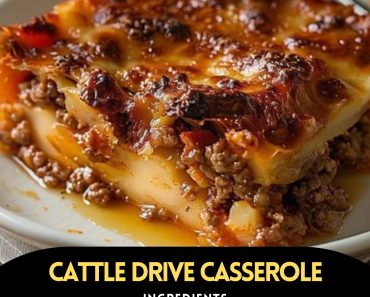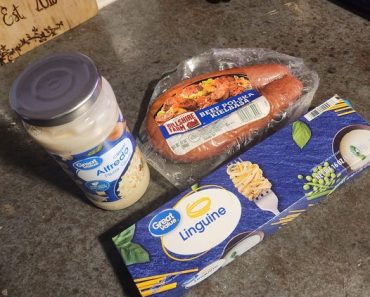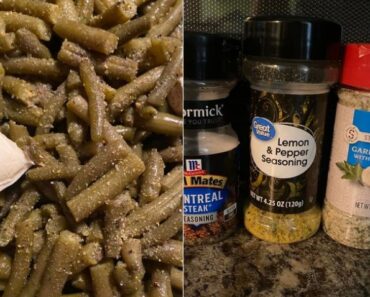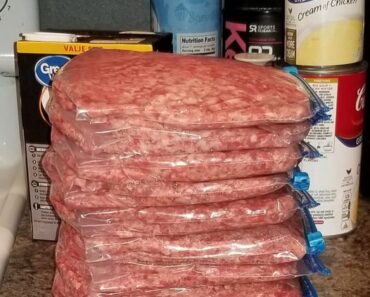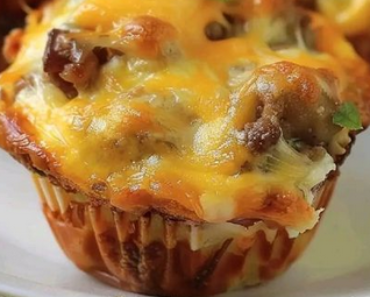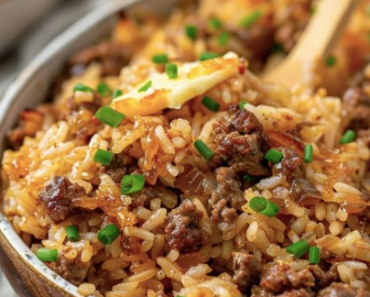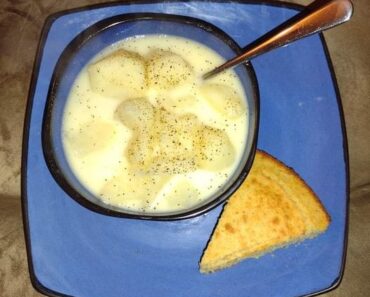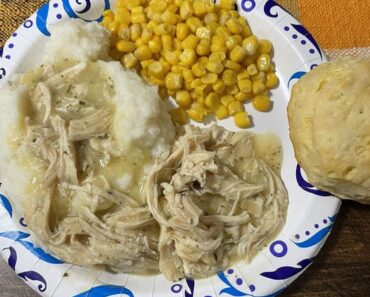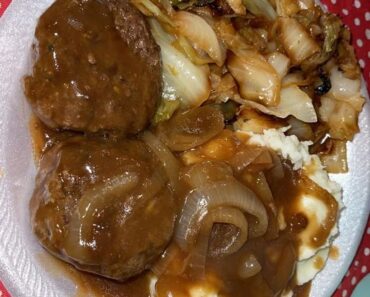
Loaded Mac & Cheese Casserole
Welcome to a comforting journey of creamy, cheesy goodness with a twist. Our Loaded Mac & Cheese Casserole is the ultimate fusion of rich flavors and delightful textures, designed to bring warmth and satisfaction to your family dinner table. This recipe is perfect for a cozy evening or a festive gathering, offering a familiar yet exciting twist on the classic mac and cheese.
Ingredients Overview
Elbow Macaroni (16 oz): The base of our casserole, elbow macaroni, provides the perfect bite-sized pasta that holds the creamy cheese sauce beautifully.
Butter (1/4 cup): Essential for creating a rich roux, butter adds a smooth, velvety texture to the sauce.
All-Purpose Flour (1/4 cup): Combined with butter, flour forms a roux, which thickens the sauce to a luscious consistency.
Milk (2 cups): The liquid foundation of our sauce, milk ensures a creamy texture without overpowering the cheese flavors.
Shredded Cheddar Cheese (2 cups): The star of the show, cheddar cheese brings a sharp, tangy flavor that pairs perfectly with the other ingredients.
Shredded Mozzarella Cheese (1 cup): Adds a gooey, melty quality to the casserole, ensuring every bite is cheesy perfection.
Cooked and Crumbled Bacon (1 cup): A savory addition that adds a delightful crunch and smoky flavor, elevating the dish to a new level of indulgence.
Chopped Green Onions (1/2 cup): Fresh and vibrant, green onions add a touch of sharpness and a pop of color.
Diced Tomatoes (1/2 cup): Juicy and sweet, tomatoes balance the richness of the cheese and bacon with their refreshing flavor.
Bread Crumbs (1/4 cup): For a crispy, golden topping that contrasts wonderfully with the creamy filling.
Salt and Pepper: To taste, ensuring the flavors are perfectly balanced.
Step-by-Step Cooking Instructions
1. Preheat the Oven
Preheat your oven to 350°F (180°C) and grease a 9×13 inch baking dish. This ensures the casserole bakes evenly and doesn’t stick to the dish.
2. Cook the Elbow Macaroni
Follow the package instructions to cook the elbow macaroni until al dente. Drain and set aside. The pasta will continue to cook in the oven, so it’s important not to overcook it at this stage.
3. Prepare the Roux
In a large saucepan, melt the butter over medium heat. Stir in the flour to create a roux, cooking for about 1 minute until it’s lightly golden. This step is crucial for developing a rich, flavorful base for the cheese sauce.
4. Make the Cheese Sauce
Gradually whisk in the milk, ensuring the mixture is smooth and thickened. This may take a few minutes, so be patient and keep stirring to avoid lumps.
5. Add the Cheeses
Stir in the shredded cheddar cheese until melted, then add the shredded mozzarella cheese. Continue stirring until the sauce is well combined and creamy. The blend of cheeses creates a perfect balance of sharp and melty flavors.
6. Combine with Macaroni and Additions
Add the cooked macaroni, crumbled bacon, chopped green onions, and diced tomatoes to the cheese sauce. Season with salt and pepper to taste. Gently stir until everything is evenly mixed and coated in the sauce.
7. Assemble the Casserole
Pour the mac and cheese mixture into the prepared baking dish, spreading it out evenly. This ensures every serving has a bit of everything.
8. Add the Topping
In a small bowl, mix the bread crumbs with a little melted butter and sprinkle it over the top of the mac and cheese. This will create a crispy, golden crust that contrasts beautifully with the creamy interior.
9. Bake
Place the casserole in the preheated oven and bake for about 25-30 minutes, or until the top is golden and bubbly. The baking process melds all the flavors together and gives the casserole its irresistible texture.
10. Let It Rest
Remove from the oven and let it rest for a few minutes before serving. This allows the casserole to set slightly, making it easier to serve and enjoy.
Storage and Reheating Tips
Storing Leftovers: Place any leftovers in an airtight container and refrigerate for up to 3 days. For longer storage, you can freeze the casserole in individual portions for up to 2 months.
Reheating: To reheat, cover the casserole with foil and warm it in a preheated oven at 350°F (180°C) until heated through. If reheating from frozen, allow it to thaw in the refrigerator overnight before reheating.
Frequently Asked Questions (FAQs)
1. Can I use a different type of pasta? Yes, you can use other short pasta shapes like penne or fusilli. Just ensure they are cooked al dente before mixing with the cheese sauce.
2. Can I make this casserole ahead of time? Absolutely! Prepare the casserole up to the baking step, cover it tightly, and refrigerate for up to 24 hours. When ready to bake, bring it to room temperature and bake as directed.
3. Can I substitute the cheeses? Yes, feel free to experiment with different cheeses like Gruyère, fontina, or even a spicy pepper jack for a unique twist.
4. How can I make this dish vegetarian? Simply omit the bacon or replace it with a plant-based bacon alternative.
5. Can I add other vegetables? Certainly! Try adding sautéed mushrooms, spinach, or bell peppers for additional flavors and nutrients.
6. Is it possible to make this gluten-free? Yes, use gluten-free pasta and substitute the flour with a gluten-free alternative like cornstarch or a gluten-free flour blend.
7. How do I prevent the cheese sauce from becoming grainy? Ensure the milk is added gradually and the cheese is melted slowly over low heat to prevent the sauce from becoming grainy.
8. Can I use non-dairy milk? Yes, unsweetened almond milk or soy milk can be used, though it may slightly alter the flavor and texture.
9. How can I make the topping extra crispy? For an extra crispy topping, mix the bread crumbs with a little grated Parmesan cheese and broil the casserole for the last few minutes of baking.
10. Can I double the recipe? Yes, you can double the ingredients and bake the casserole in a larger dish or two smaller dishes.
11. What if I don’t have green onions? You can substitute with finely chopped chives or omit them entirely if preferred.
12. How do I know when the casserole is done? The casserole is done when the top is golden and bubbly, and the cheese sauce is hot and melty.
13. Can I use pre-cooked pasta? It’s best to cook the pasta fresh, but pre-cooked pasta can be used if you’re in a pinch. Just ensure it’s al dente and not overcooked.
14. Can I add protein to this dish? Yes, cooked chicken, ham, or even shrimp can be great additions for extra protein.
15. How do I keep the mac and cheese creamy when reheating? Add a splash of milk or cream before reheating to help restore the creaminess.
16. Can I add hot sauce for extra flavor? Absolutely! A dash of hot sauce can add a nice kick to the casserole.
17. What type of bread crumbs should I use? Panko bread crumbs work great for a crispy topping, but regular bread crumbs will also do the job.
18. Can I add garlic to the sauce? Yes, minced garlic sautéed in the butter before adding the flour can add a wonderful flavor to the sauce.
19. How can I make the dish lower in fat? Use low-fat cheese and milk, and reduce the amount of butter used in the roux.
20. What sides go well with this casserole? A simple green salad or steamed vegetables are great sides to balance the richness of the casserole.
20 Culinary Secrets for Perfection
1. Use freshly grated cheese to ensure it melts smoothly into the sauce.
2. Don’t overcook the pasta; al dente is perfect as it will cook further in the oven.
3. Gradually add the milk to the roux, whisking constantly to avoid lumps.
4. Stir the cheese sauce constantly over low heat to prevent it from becoming grainy.
5. Use a blend of cheeses for a more complex flavor and better melting properties.
6. Season the cheese sauce to taste before combining with the pasta for optimal flavor balance.
7. Add a touch of mustard powder to the cheese sauce for a subtle depth of flavor.
8. Ensure all mix-ins (bacon, vegetables) are well-cooked and drained of excess moisture.
9. Let the casserole rest before serving to allow the sauce to set slightly.
10. For extra creaminess, add a dollop of sour cream or cream cheese to the sauce.
11. Toast the bread crumbs lightly before adding them for an even crispier topping.
12. Add a splash of broth if the sauce becomes too thick.
13. Mix the topping with a bit of melted butter for an even, golden crust.
14. Include a hint of nutmeg in the cheese sauce for a warm, aromatic touch.
15. Avoid pre-shredded cheese; it often contains anti-caking agents that affect melting.

